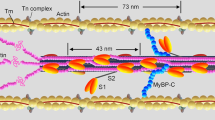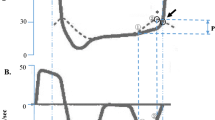Tension in contracting muscle fiber under conditions of ramp stretching rapidly increases, but after reaching a critical stretch Pc sharply decreases. To find out the cause of these changes in muscle fiber tension, we stopped stretching before and after reaching Pc and left the fiber stretched for 50 msec. After rapid tension drop, the transient tension rise not accompanied by fiber stiffness increase was observed only in fibers heated to 25°C and stretched to Pc. Under other experimental conditions, this growth was absent. We suppose that stretch of the fiber to Pc induces transition of stereo-specifically attached myosin heads to pre-power stroke state and when the stretching is stopped, they make their step on actin and generate force. When the tension reaches Pc, all stereospecifically attached myosin heads turn out to be non-stereospecifically, or weakly attached to actin, and are unable to make the force-generating step.
Similar content being viewed by others
References
Bershitsky SY, Tsaturyan AK. The elementary force generation process probed by temperature and length perturbations in muscle fibres from the rabbit. J. Physiol. 2002;540(Pt 3):971-988.
Colombini B, Nocella M, Benelli G, Cecchi G, Bagni MA. Effect of temperature on cross-bridge properties in intact frog muscle fibers. Am. J. Physiol. Cell Physiol. 2008;294(4):C1113-C1117.
Ferenczi MA, Bershitsky S Y, Koubassova NA, Kopylova GV, Fernandez M, Narayanan T, Tsaturyan AK. Why muscle is an efficient shock absorber. PLoS One. 2014;9(1):e85739.
Getz EB, Cooke R, Lehman SL. Phase transition in force during ramp stretches of skeletal muscle. Biophys J. 1998;75(6):2971-2983.
Minozzo FC, Rassier DE. Effects of blebbistatin and Ca2+ concentration on force produced during stretch of skeletal muscle fibers. Am. J. Physiol. Cell Physiol. 2010;299(5):C1127-C1135.
Nocella M, Bagni MA, Cecchi G, Colombini B. Mechanism of force enhancement during stretching of skeletal muscle fibres investigated by high time-resolved stiffness measurements. J. Muscle Res. Cell Motil. 2013;34(1):71-81.
Piazzesi G, Linari M, Reconditi M, Vanzi F, Lombardi V. Cross-bridge detachment and attachment following a step stretch imposed on active single frog muscle fibres. J. Physiol. 1997;498(Pt 1):3-15.
Pinniger GJ, Ranatunga KW, Offer GW. Crossbridge and non-crossbridge contributions to tension in lengthening rat muscle: force-induced reversal of the power stroke. J. Physiol. 2006;573(Pt 3):627-643.
Author information
Authors and Affiliations
Corresponding author
Additional information
Translated from Byulleten’ Eksperimental’noi Biologii i Meditsiny, Vol. 162, No. 7, pp. 15-18, July, 2016
Rights and permissions
About this article
Cite this article
Kochubei, P.V., Bershitsky, S.Y. Possible Cause of Nonlinear Tension Rise in Activated Muscle Fiber during Stretching. Bull Exp Biol Med 162, 11–13 (2016). https://doi.org/10.1007/s10517-016-3532-x
Received:
Published:
Issue Date:
DOI: https://doi.org/10.1007/s10517-016-3532-x




